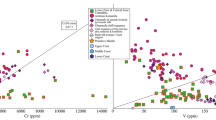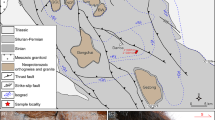Abstract
The main objective of this study is to contribute to the understanding of the deformation of leucosome and its residue in diatexites and granulites using as examples two units of the Socorro-Guaxupé Nappe, the metasedimentary-derived migmatite unit and the basal granulite unit, from the southernmost portion of the Brasília Orogen. The first unit is dominated by diatexite at its base, and the second unit is composed primarily of felsic granulite. After textural characterization of oriented samples, deformation temperatures are determined by (i) quartz c-axis fabric thermometry and (ii) cathodoluminescence-based Ti-in-quartz thermometry. The results are compared with thermobarometry data obtained from the associated residues. This establishes that the crystallization in the metasedimentary-derived migmatite unit and the basal granulite unit occurred along the cooling portion of the P–T path, but in some portions of the P–T path, these units were deformed and might be related to medium and high temperatures. Therefore, when the granulite is in the solid state, the diatexite is still in the dominantly liquid state, thus the granulite registers higher deformation temperatures that the diatexite simply cannot register due to its still mostly liquid state.












Similar content being viewed by others
Availability of data and materials
Not applicable.
Code availability
Not applicable.
References
Arzi AA (1978) Critical phenomena in the rheology of partially melted rocks. Tectonophysics 44:173–184. https://doi.org/10.1016/0040-1951(78)90069-0
Campos Neto MC, Caby R (1999) Neoproterozoic high-pressure metamorphism and tectonic constraint from the nappe system south of the São Francisco Craton, southeast Brazil. Precambrian Res 97(1):3–26. https://doi.org/10.1016/S0301-9268(99)00010-8
Campos Neto MC, Caby R (2000) Terrane accretion and upward extrusion of high-pressure granulites in the Neoproterozoic nappes of southeast Brazil: petrologic and structural constraints. Tectonics 19(4):669–687. https://doi.org/10.1029/1999TC900065
Campos Neto MC, Basei MAS, Vlach SRF, Caby R, Szabo GAJ, Vasconcelos P (2004) Migração de Orógenos e Superposição de Orogêneses: Um Esboço da Colagem Brasiliana no Sul do Cráton do São Francisco, SE—Brasil. Geol USP Ser Cient 4(1):13–40. https://doi.org/10.5327/s1519-874x2004000100002
Campos Neto MC, Janasi VA, Basei MAS, Siga O Jr (2007) Sistema de nappes Andrelândia, setor oriental: litoestratigrafia e posição estratigráfica. Rev Brasil Geociênc 37(4):47–60. https://doi.org/10.25249/0375-7536.200737S44760
Campos Neto MC, Basei MAS, Janasi VA, Moraes R (2011) Orogen migration and tectonic setting of the Andrelândia Nappe System: an Ediacaran western Gondwana collage, south of São Francisco Craton. J S Am Earth Sci 32(4):393–406. https://doi.org/10.1016/j.jsames.2011.02.006
Cioffi C, Campos Neto M, Moller A, Chung B (2016) Paleoproterozoic continental crust generation events at 2.15 and 2.08 Ga in the basement of the southern Brasília Orogen, SE Brazil. Precambrian Res 275:176–196. https://doi.org/10.1016/j.precamres.2016.01.007
Del Lama EA, Zanardo A, Oliveira MAF (1994) Geotermobarometria em rochas do Complexo Campos Gerais ao norte da Zona de Cisalhamento Varginha. Rev Brasil Geociênc 24(4):1–7. https://doi.org/10.25249/0375-7536.1994233239
Del Lama EA, Zanardo A, Oliveira MAF, Morales N (2000) Exhumation of high-pressure granulites of the Guaxupé complex, Southeastern Brazil. Geol J 35(3–4):231–249. https://doi.org/10.1002/gj.859
Faleiros F, Moraes R, Pavan M, Campanha G (2016) A new empirical calibration of the quartz c-axis fabric opening-angle deformation thermometer. Tectonophysics 671:173–182. https://doi.org/10.1016/j.tecto.2016.01.014
Harley SL (1989) The origins of granulites: a metamorphic perspective. Geol Mag 126(3):215–247. https://doi.org/10.1017/S0016756800022330
Harley SL (1992) Proterozoic granulite terranes. In: Condie KC (ed) Proterozoic crustal evolution—developments in precambrian geology, 10th edn. Elsevier, Amsterdam, pp 301–359
Holland TJB, Powell R (2011) An improved and extended internally consistent thermodynamic dataset for phases of petrological interest, involving a new equation of state for solids. J Metamorph Geol 29(3):333–383. https://doi.org/10.1111/j.1525-1314.2010.00923.x
Kirschner D, Teyssier C (1991) Quartz c-axis fabric differences between porphyroclasts and recrystallized grains. J Struct Geol 13(1):105–109. https://doi.org/10.1016/0191-8141(91)90106-S
Kretz R (1982) Transfer and exchange equilibria in a portion of the pyroxene quadrilateral as deduced from natural and experimental data. Geochem Cosmochim Acta 46(3):411–422. https://doi.org/10.1016/0016-7037(82)90232-0
Kruhl JH (1996) Prism- and basal-plane parallel subgrain boundaries in quartz: a microstructural geothermobarometer. J Metamorph Geol 14:581–589. https://doi.org/10.1046/j.1525-1314.1996.00413.x
Kruhl JH (1998) Reply: Prism- and basal-plane parallel subgrain boundaries in quartz: a microstructural geothermobarometer. J Metamorph Geol 16:142–146
Law RD (2014) Deformation thermometry based on quartz c-axis fabrics and recrystallization microstructures: a review. J Struct Geol 66:129–161. https://doi.org/10.1016/j.jsg.2014.05.023
Means WD (1981) The concept of steady-state foliation. Tectonophysics 78(1–4):179–199. https://doi.org/10.1016/0040-1951(81)90013-5
Moraes R, Benetti BY, Motta RG (2015) Ultrahigh-temperature metamorphism in granulites with “no classic” mineral assemblage. In: 8th Hutton symposium on granites and related rocks, Florianópolis
Motta RG (2018) Formação, transformação e evolução da crosta continental inferior: investigando o Orógeno Brasília Meridional. Doctor Thesis, University of São Paulo. https://doi.org/10.11606/T.44.2018.tde-06122018-153140
Motta RG, Fitzsimons ICW, Moraes R, Johnson TE, Schuindt S, Benetti BY (2021) Recovering P-T–t paths from ultra-high temperature (UHT) felsic orthogneiss: an example from the Southern Brasília Orogen, Brazil. Precambrian Res 359:106222. https://doi.org/10.1016/j.precamres.2021.106222
Müller A, Wiedenbeck M, van den Kerkhof AM, Kronz A, Simon K (2003) Trace elements in quartz—a combined electron microprobe, secondary ion mass spectrometry, laser-ablation ICP-MS, and cathodoluminescence study. Eur J Mineral 15:747–763. https://doi.org/10.1127/0935-1221/2003/0015-0747
Nascimento MB, Oliveira MAF (2012) Geotermobarometria de granulitos associados à supracrustais na porção norte do Complexo Guaxupé—região Arceburgo—Santa Cruz do Prata, MG. Geociências 31:207–228. https://doi.org/10.1590/S0001-37652002000200009
Pavan M, Moraes R, Sawyer EW (2021) Changes in the composition of anatectic melt and its complementary residue by forward-modelling using THERMOCALC. Lithos 296–297:106220. https://doi.org/10.1016/j.lithos.2021.106220
Perkins D, Chipera S (1985) Garnet-orthopyroxene-plagioclase-quartz barometry: refinement and application to the English River subprovince and the Minnesota River valley. Contrib Mineral Petr 89:69–80. https://doi.org/10.1007/BF01177592
Powell R, Holland TJB (1994) Optimal geothermometry and geobarometry. Am Miner 79(1–2):120–133
Rocha BC, Moraes R, Möller A, Cioffi CR, Jercinovic MJ (2017) Timing of anatexis and melt crystallization in the Socorro-Guaxupé Nappe, SE Brazil: insights from trace element composition of zircon, monazite and garnet coupled to U—Pb geochronology. Lithos 277:337–355. https://doi.org/10.1016/j.lithos.2016.05.020
Rocha BC, Moraes R, Möller A, Cioffi CR (2018) Magmatic inheritance vs. UHT metamorphism: zircon petrochronology of granulites and charnockitic leucosomes of the Socorro-Guaxupé Nappe, SE Brazil. Lithos 314–315:16–39. https://doi.org/10.1016/j.lithos.2018.05.014
Rosenberg C, Handy M (2005) Experimental deformation of partially melted granite revisited; implications for the continental crust. J Metamorph Geol 23:19–28. https://doi.org/10.1111/j.1525-1314.2005.00555.x
Rosenberg C, Medvedev S, Handy MR (2007) Effects of melting on faulting and continental deformation. In: Handy MR, Hirth G, Hovius N (eds) Tectonic faults: agents of change on a dynamic earth. MIT Press, Cambridge, pp 357–402
Salazar Mora CA, Campos Neto MC, Basei MAS (2014) Syn-collisional lower continental crust anatexis in the Neoproterozoic Socorro-Guaxupé Nappe System, southern Brasília Orogen, Brazil: constraints from zircon U-Pb dating, Sr–Nd–Hf signatures and whole-rock geochemistry. Precambrian Res 255(3):847–864. https://doi.org/10.1016/j.precamres.2014.10.017
Sawyer EW (1991) Disequilibrium melting and the rate of melt residuum separation of mafic rocks from the Grenville Front, Quebec. J Petrol 32(4):701–738. https://doi.org/10.1093/petrology/32.4.701
Sawyer EW (2001) Melt segregation in the continental crust: distribution and movement of melt in antatectic rocks. J Metamorph Geol 19(3):291–309. https://doi.org/10.1046/j.0263-4929.2000.00312.x
Sawyer EW (2010) Migmatites formed by water-fluxed partial melting of a leucogranodiorite protolith: microstructures in the residual rocks and source of the fluid. Lithos 116(3–4):273–286. https://doi.org/10.1016/j.lithos.2009.07.003
Soto JI, Soto VM (1995) PTMAFIC: Software package for thermometry, barometry, and activity calculations in mafic rocks using an IBM-compatible computer. Comput Geosci 21(5):619–652. https://doi.org/10.1016/0098-3004(94)00101-Y
Spear FS, Wark DA (2009) Cathodoluminescence imaging and titanium thermometry in metamorphic quartz. J Metamorph Geol 27:187–205. https://doi.org/10.1111/j.1525-1314.2009.00813.x
Stipp M, Stüntz H, Heilbronner R, Schmid SM (2002) The Eastern Tonale Fault Zone: a “natural laboratory” for crystal plastic deformation of quartz over a temperature range from 250 to 700 °C. J Struct Geol 24(12):1861–1884. https://doi.org/10.1016/S0191-8141(02)00035-4
Tasco LH, Moraes R (2019) Evaluation of the contributions of possible sources to the leucosome of the diatexite of Socorro-Guaxupé Nappe, in the Alfenas Region, MG, Brazil. Braz J Geol 49(1):e20180066. https://doi.org/10.1590/2317-4889201920180066
Tedeschi MF, Pedrosa-Soares A, Dussin I, Lanari P, Novo T, Pinheiro MAP, Lana C, Peters D (2018) Protracted zircon geochronological record of UHT garnet-free granulites in the Southern Brasília orogen (SE Brazil): petrochronological constraints on magmatism and metamorphism. Precambrian Res 316:103–126. https://doi.org/10.1016/j.precamres.2018.07.023
Tullis J, Christie JM, Griggs DT (1973) Microstructures and preferred orientations of experimentally deformed quartzites. Bull Geol Soc Am 84(1):297–314. https://doi.org/10.1144/GSL.SP.2001.200.01.12
Vigneresse JL, Barbey P, Cuney M (1996) Rheological transitions during partial melting and crystallization with application to felsic magma segregation and transfer. J Petrol 37(6):1579–1600. https://doi.org/10.1093/petrology/37.6.1579
Wark DA, Watson EB (2006) TitaniQ: a titanium-in-quartz geothermometer. Contrib Mineral Petrol 152:743–754. https://doi.org/10.1007/s00410-006-0132-1
Weinberg R, Hasalová P (2015) Water-fluxed melting of the continental crust: a review. Lithos 212–215:158–188. https://doi.org/10.1016/j.lithos.2014.08.021
Weinberg RF, Vernon RH, Schmeling H (2021) Processes in mushes and their role in the differentiation of granitic rocks. Earth Sci Rev 220:103665. https://doi.org/10.1016/j.earscirev.2021.103665
Wood BJ, Banno S (1973) Garnet-orthopyroxene and orthopyroxene-clinopyroxene relationships in simple and complex systems. Contrib Mineral Petrol 42:109–124. https://doi.org/10.1007/BF00371501
Zanardo A, Morales, N, Farias de Oliveira MA, Del Lama EA (2006) Tectono-lithologic association of the Alterosa paleo suture zone, southeastern Brazil. Rev UnG Geociênc 5(1):103–117. http://revistas.ung.br/index.php/geociencias/article/viewFile/99/191
Acknowledgements
Authors would like to thank São Paulo Research Foundation (FAPESP—by its acronyms in Portuguese) for financial support (Grant 16/22627-3). LH Tasco acknowledgments his CAPES (88882.377662/2019-01) scholarship. All analyses were made at the Laboratories of the NAP Geoanalítica, Institute of Geosciences, University of São Paulo, Brazil. RM is a CNPq research fellow (305720/2020-1). Authors would like to thank both reviewers, Jörn H. Kruhl for their constructive reviews and Edward W. Sawyer not only for their comments, but also for their English suggestions that helped to improve the manuscript.
Funding
Financial research support by FAPESP (grant 16/22627-3).
Author information
Authors and Affiliations
Contributions
LH Tasco did field work, petrography, deformation temperatures calculation, thermobarometry calculations and prepared the figures. R Moraes provided guidance regarding Brazilian Geology, petrography, work on deformation temperatures and thermobarometry aspects and took part in the fieldwork as well.
Corresponding authors
Ethics declarations
Conflict of interest
Not applicable.
Rights and permissions
About this article
Cite this article
Hernandez Tasco, L., Moraes, R. Relation between partial melting, granulite metamorphism, crystallization, deformation of leucosome and the influence of these processes on the cooling of the root of a hot orogen. Int J Earth Sci (Geol Rundsch) 111, 1395–1412 (2022). https://doi.org/10.1007/s00531-022-02185-2
Received:
Accepted:
Published:
Issue Date:
DOI: https://doi.org/10.1007/s00531-022-02185-2




